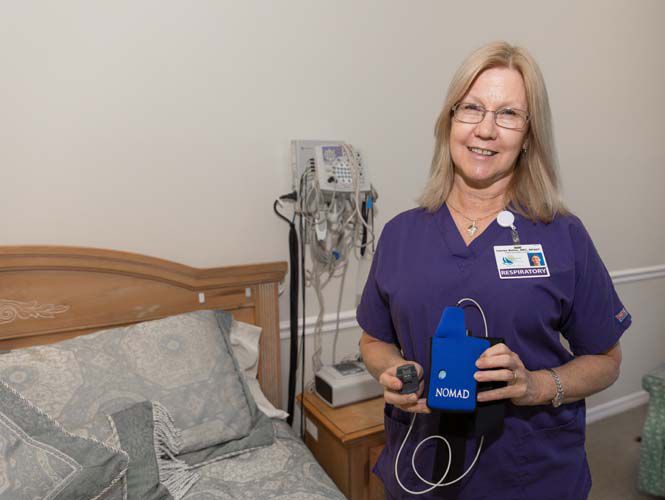According to the Centers for Disease Control and Prevention, more than a quarter of the U.S. population suffers from some kind of sleep disorder, and the National Institutes of Health estimates between 12 million and 18 million Americans have a potentially lethal affliction called “obstructive sleep apnea.”
The American Journal of Respiratory and Critical Care has linked sleep apnea to an increased risk for developing diabetes, depression, memory loss or confusion, sexual dysfunction, high blood pressure, weight gain and stroke.
Unfortunately, doctors are rarely able to detect this problem during routine office visits and there is no blood test to help diagnose it.
Worse, according to Lauren Butler, a sleep technologist at the Sebastian River Medical Center’s Sleep Disorder Center, insurers are making it even more difficult to detect. Or, more complicated, anyway.
“If you are a non-Medicare patient,” explains Butler, “and you have Blue Cross, Aetna, Cigna [or any of several other insurers] and you don’t have a lot of other things wrong with you, your insurance is not going to approve a regular in-lab sleep study anymore.”
Apnea means “without breath,” and that’s exactly what those who suffer from this condition experience: They actually stop breathing as they sleep though they are rarely aware of it. Episodes can be as brief as a few seconds or they can last much longer and the consequences can be dangerous and sometimes even fatal.
“We had a 49-year-old who coded at home a few years ago,” Butler recalls. “He had apnea so bad but didn’t want to get it taken care of. Fortunately his wife was there with him and was able to get 911 over in time. They brought him back, revived him, and they blamed his entire problem on sleep apnea.”
Forty-nine is a fairly young age for such severe apnea. The Mayo Clinic says “sleep apnea occurs significantly more often in older adults,” and then adds, “men are twice as likely to have sleep apnea, but women increase their risk if they’re overweight, and that risk also appears to rise after menopause.”
Despite the dire risks associated with sleep apnea and the difficulty of diagnosing it, most insurance companies will not pay for an in-lab overnight test – which was the standard diagnostic tool up until a few years ago, when insurance companies started declining payment – until other attempts at diagnosis have been made.
So, if insurers won’t immediately approve a sleep lab test called a polysomnogram (PSG) – during which the patient spends a night at a sleep disorder center with a series of wires attached to his or her body to measure and record brain activity, eye movement, heart rate, blood pressure, the amount of oxygen in the blood along with air movement through the nose while the patient sleeps – what’s to prevent a problem from getting much, much worse?
The answer is to think small. About as small as a cellphone or a USB wall-charger: a home sleep-testing device.
As Butler puts it, “Home sleep testing has become the new wave in sleep. All the [sleep] labs now are trying to do the home sleep study, because insurance wants it basically like a screening tool.”
These downsized devices have belts that go around the chest and belly to measure breathing effort, oxygen levels and air flow
They are not, however, foolproof. Or even people-proof.
“Some people,” Butler points out, “in the middle of the night will rip them off, because it is just a natural instinct to tear something off of you. With the home sleep studies, if you tear it off, it is an unsuccessful test. Then the insurance will say, ‘OK, do it again.’ So you do it one more time at home and if the patient pulls it off again it is [another] bad test.”
Only then will many insurers finally approve an in-lab sleep study.
The National Heart, Lung & Blood Institute flatly states that these in-lab PSG tests are painless and that patients “will go to sleep as usual, except they’ll have sensors attached to their scalp, face, chest, limbs and a finger. The staff at the sleep center will use the sensors to check on you throughout the night.”
A sleep specialist will then review the findings and determine if you have sleep apnea and how severe it is. He or she will then use the results to plan treatment.
The most common treatment is a CPAP, or continuous positive airway pressure machine, which uses a breathing mask and “mild air pressure to keep your airways open while you sleep,” according to the NIH.
Fortunately for patients, CPAP technology has improved over the years. Once large and loud, CPAPs are now sleek and very nearly silent with much more comfortable systems to deliver that continuous air flow.
And, as Butler points out, even if someone has been using a CPAP for years, it’s a good idea to have a “re-titration” or re-setting of the device. “You really should,” she explains as diplomatically as possible, because with age, “your muscle tone changes and your weight changes,” so making sure your CPAP is at the right setting for you now is important.
The Sebastian River Sleep Disorder Center is located well south and west of the hospital’s campus at 705-A Commerce Center Drive. The phone number is 772-581-5655.

